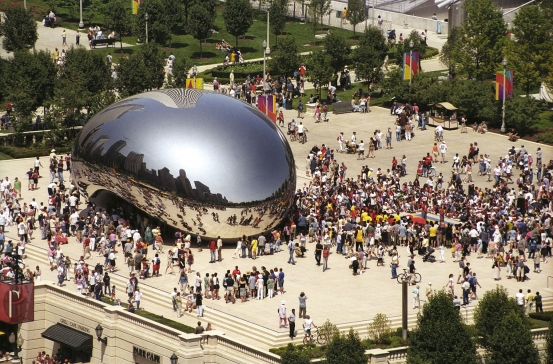The Intrinsic Impact of Art on Community
by Andrew Swensen
Much good research has examined the intrinsic impact of art, and the idea has appropriately shifted how we justify the role of art in an individual’s life (cf. links below). To simplify a not-so-simple concept, intrinsic impact refers to emotional and psychological consequences of art. We have a motivation to consume art because we receive something valuable in the form of a meaningful emotional experience, the evocation of intellectual curiosity, or something that awakens humor or a play response.
All of this might sound like a statement of the obvious, but the truth is that when we talk about justifying the arts, we have a habit of throwing intrinsic impact out the window and talking in terms of extrinsic impact. When we want to justify art to government for a public art grant, to a foundation for a new project, or – perhaps most importantly – to a school district for retaining arts education, then we go to the measurables of how art benefits things that are non-artistic parts of life. The discourse of non-art disciplines, especially economics, has apparently co-opted the conversation about art when we want to substantiate its value. We need to talk about how playing the violin improves math scores, how visual art improves spatial/temporal skills so that we can be better problem-solvers at work. As I have argued before on arts education, this line of reasoning diminishes art if we do not view the extrinsic consequence of art as secondary to the intrinsic consequence. Art moves us, and that is more important than the chain-reaction result of it also making us better at math or at our jobs.
I have two related hypotheses, and the first is this: What is true of the psychological is also true of the sociological. When one hears talk of justifying the arts for communities, there has been a frequent tilt toward justifying the arts through non-artistic, non-aesthetic considerations. Extrinsic impacts. We hear how a new sculpture on a downtown plaza will attract paying customers to local businesses, or how arts organizations should be supported because they employ X number of people and put Y dollars into the economy. I do not want to diminish the importance of studies on the economic impact of art, because it is real and legitimately important. Yet I do want to advance the idea that the intrinsic impact on our communities might be more important.
So let’s play out the hypothesis of intrinsic impact. Art can make a whole community happier and can lead to a sense of collective identity and fulfillment. This also might seem a statement of the obvious because art gives us many of the archetypes of our collective identities. However, the closest we get to this line of thinking is when we speak of art as improving the “quality of life” in a community. The phrase is problematically vague but heads in the right direction. We should push further and turn the entire argument on its head: art makes societies more fulfilled, and more fulfilled societies function better on all levels. They are more productive and more collaborative, and they have a shared sense of purpose and identity. One thinks of Chicago’s Millennium Park, the vibrancy of the theater district in New York, or those citywide “cow parades” where artists use the same animal to make a hundred different art works around town — first cows, but later horses, pigs, guitars and even my personal favorite: the orcas of Vancouver.
Yes, art makes communities more fulfilled. And yes, a fortunate byproduct of that sensibility is improved economic prosperity. So let’s talk about making artful communities because of the intrinsic impact, and then be pleasantly grateful for the secondary extrinsic consequences that follow.
These thoughts came to mind as I read a recent article on Pittsburgh, which has been regularly recognized as the “most livable” city in America and recently was documented to have higher happiness than the national average. What is interesting to me is the fact that when Pittsburgh and the other cities that frequently make such lists are discussed, the arts always makes it into the equation. Sure, it is part of that “quality of life” consideration, along with good healthcare and affordable housing, but we should also notice how the arts always trip off the lips of someone interviewed for these articles. Such is the case when the admissions representative of a local business school talks about why a candidate should want to relocate here. Yes, the business school professional first talks in the language of art, and the inference that I draw is that all this livability and happiness stems from the sociology of intrinsic impact…which leads me to my second hypothesis.
The second hypothesis is that our discourse in the 21st century is moving in this direction of intrinsic impact by merging the discourses of areas considered discrete and separate by 20th-century discussions. In the language of the 20th century, we talked in terms of some distinction between the dreamy world of art and the “real” world of economics and business. Yet in the 21st century, we are shifting our cultural language to a sense for the interconnectedness of all our pursuits. One example that inspired this line of thinking comes from the work of the Pittsburgh Technology Council, bringing together artists and technologists in the Arts + Technology Initiative (about which we wrote recently) in order to benefit both. Since both are in the business of innovation, they flow together in a natural symbiosis, each benefiting the other. Similarly, if you watch a few TED talks, you will see a pattern of how aesthetic thinking has the consistent power to transform all thinking. Lest my lens be too focused on my beloved Pittsburgh (I might have used my beloved former hometown of Madison, Wisconsin as well!), I will broaden the conversation to say that we have evidence of this new discourse from around the world, and the phenomenon of TED talks really marks a culture shift. My favorite example here is from the neuroscientist Jill Bolte Taylor, who talks about her experience during a stroke. She describes what happens when a stroke causes her left brain to cease functioning for a span of time, and her right brain opens a world of insight – a world of artistically inclined thought that shapes a scientist’s understanding of experience.
The reality, as Taylor reveals to us, is that we are whole beings who thrive on those things that make our minds and spirits find meaning and happiness. Art takes us there, and may even help us to put into context all those other things that we do — like science and economic life — and its intrinsic impact affects us as both individuals and societies large and small.
*****
Suggested Reading
Counting New Beans: Intrinsic Impact and the Value of Art. A collection of essays and research presented by Theatre Bay Area, on the intrinsic impact of theater.
WolfBrown’s research study “Assessing the Intrinsic Impacts of a Live Performance. The consulting firm WolfBrown has online materials related to a study of intrinsic impact, conducted at multiple performance venues.
“Intrinsic Impact Research: A New Frontier in Making a Case for the Arts” This past article for TMD presents original research on the intrinsic impact of visual art for museum attendees.











On the topic of intrinsic vs. extrinsic, I have also been appalled by recent attempts to promote computer science and programming among young people by appealing to (often unrealistic) extrinsic justifications. The fact is the computer programming is primarily an art, as is mathematics, and I believe that in fact, the very reason they are not as popular in the United States in particular is because of the way they are justified and perceived at an early age as some kind of utilitarian chore. For a passionate critique of this view, and a defense of mathematics as an art, there is probably no better contemporary example than Paul Lockhart’s “A Mathematician’s Lament”, originally an essay http://www.maa.org/external_archive/devlin/devlin_03_08.html then a book https://en.wikipedia.org/wiki/A_Mathematician%27s_Lament
I bring this up because I think all of us who believe in the intrinsic value and joy of art in our different fields must join together to promote it.
Well said. When we consider any discipline, it is unfortunate to think that we subordinate the pure benefits (intrinsic) to the applied benefits (extrinsic).
I just saw this article: http://www.city-journal.org/2013/23_4_urb-art.html I don’t necessarily endorse the opinions voiced in it, but it’s good people are talking about art.
And a rejoinder to that: http://text-patterns.thenewatlantis.com/2013/12/the-uses-of-art.html
I think the complexity of art is what makes it hard to talk about, because the temptation is always to focus on one particular aspect, especially in reaction to or against some other aspect. I don’t actually know the solution, except that silence is not an option either.